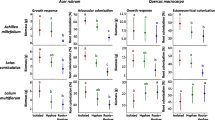Abstract
Morphological classification of ectomycorrhizas ofPinus densiflora was conducted. Fifty soil samples containing pine ectomycorrhizas, and 40 pine seedlings were collected randomly in two separate reforested stands ofP. densiflora (45 yr old) from May 1992 to October 1994. Fifty-six types of ectomycorrhizas could be classified based upon microscopically observable morphological characteristics. Fifty percent of the types showed cystidia or other specific characteristics such as laticiferous hyphae in the fungal sheaths, verrucose emanating hyphae and a positive hyphal reaction to UV irradiation. Four mycorrhizal types were confirmed to be formed by the fungiRussula delica, R. mariae, R. nigricans, andCenococcum geophilum, respectively. Although the other 52 types were unidentified mycobionts at species level, it was inferred that they were formed by the fungiHebeloma, Lactarius, Russula andTuber. There was a slight difference in the observed mycorrhizal types between the tree ages.
Similar content being viewed by others
Literature cited
Agerer, R. 1987–1994. Color atlas of ectomycorrhizas, Einhorn-Verlag, Schwabisch Gmünd.
Agerer, R. 1991. Characterization of ectomycorrhiza. In: Methods in microbiology, vol. 23, (ed. by Norris, J. R., Read, D. J. and Varma, A. K.), pp. 25–73. Academic Press, London.
Agerer, R. 1995. Anatomical characteristics of identified ectomycorrhizas: an attempt towards a natural classification. In: Mycorrhiza: structure, function, molecular biology and biotechnology, (ed. by Varma, A. and Hock, B.), pp. 685–735. Springer-Verlag, Berlin.
Alexander, I. J. 1981. ThePicea sitchensis+Lactarius rufus mycorrhizal association and its effects on seedling growth and development. Trans. Br. Mycol. Soc.76: 417–423.
Bruns, T. 1995. Thoughts on the processes that maintain local species diversity of ectomycorrhizal fungi. Plant Soil170: 63–73.
Chilvers, G. A. 1968. Some distinctive types of eucalypt mycorrhiza. Aust. J. Bot.16: 49–70.
Chu-Chou, M. 1979. Mycorrhizal fungi ofPinus radiata in New Zealand. Soil Biol. Biochem.11: 557–562.
Danielson, R. M. 1984. Ectomycorrhizal associations in jack pine stands in northeastern Alberta. Can. J. Bot.62: 932–939.
Dominik, T. 1969. Key to ectotrophic mycorrhizae. Folia Forest Polonica, Ser. A15: 309–321.
Duckett, J. B. and Read, D. J. 1989. The use of the fluorescent dye, 3,3′-dihexyloxacarbocyanine iodide, for the selective staining of ascomycete fungi associated with liverwort rhizoids and ericoid mycorrhizal roots. New Phytol.118: 259–272.
Fassi, B. 1965. Ectotrophic mycorrhizae produced byEndogone lactiflua Berk. onPinus strobus L. Allionia11: 7–15.
Fontana, A. and Centrella, E. 1967. Ectomycorrhizae produced by hypogeous fungi. Allionia13: 149–176.
Godbout, C., and Fortin, J. A. 1985. Synthesized ectomycorrhizae of aspen: fungal genus level structural characterization. Can. J. Bot.63: 252–262.
Harley, J. L. and Smith, S. E. 1983. Mycorrhizal symbiosis, Academic Press, London.
Hawksworth, D. L., Sutton, B. C. and Ainthworth, G. C. 1983. Ainthworth & Bisby's Dictionary of the fungi, 7th ed., pp. 444–445, CAB, Surrey.
Imazeki, R. and Hongo, T. 1987. Colored illustrations of mushrooms of Japan, vol. 1, Hoikusha, Osaka. (In Japanese).
Imazeki, R. and Hongo, T. 1989. Colored illustrations of mushrooms of Japan, vol. II, Hoikusha, Osaka. (In Japanese).
Ingleby, K., Mason, P. A., Last, F. T. and Fleming, L. V. 1990. Identification of ectomycorrhizas. HMSO, London.
Lamb, R. J. and Richards, B. N. 1970. Some mycorrhizal fungi ofPinus radiata andP. eliottii var.eliottii in Australia. Trans. Br. Mycol. Soc.54: 371–378.
Masui, K. 1927. A study of the ectotrophic mycorrhizas of woody plants. Mem. Coll. Sci. Kyoto Univ. Ser. B3: 149–279.
Mikola, P. 1973. Application of mycorrhizal symbiosis in forest practice. In: Ectomycorrhizae: Their ecology and physiology, ed. by Marks, G. C. and Kozlowski, T. T.), pp. 383–411. Academic Press, London.
Molina, R. and Trappe, J. M. 1982. Pattern of ectomycorrhizal host specificity and potential among Pacific northwest conifers and fungi. Forest Sci.28: 423–458.
Molina, R., Massicotte, H. and Trappe, J. M. 1992. Specificity phenomena in mycorrhizal symbiosis: Community-ecological consequences and practical implications. In: Mycorhizal functioning, (ed. by Allen, M. F.), pp. 357–423. Chapman and Hall, New York.
Newton, A. C. and Pigott, C. D. 1991. Mineral nutrition and mycorrhizal infection of seedling oak and birch III. Epidemiological aspects of ectomycorrhizal infection, and the relationship to seedling growth. New Phytol.117: 53–60.
Newton, A. C. 1992. Toward a functional classification of ectomycorrhizal fungi. Mycorrhiza2: 75–79.
Palenzona, M., Chevalier, G. and Fontana, A. 1972. Mycorrhizal synthesis between the mycelia in culture ofTuber brumale, T. melanosporum, T. rufum, and conifer and broad-leaves seedlings. Allionia18: 41–52.
Pigott, C. D. 1982. Fine structure of mycorrhiza formed byCenococcum geophilum Fr. onTilia cordata Mill. New Phytol.92: 501–512.
Satake, Y., Hara, H., Watari, S. and Tominari, T. 1989. Wild flowers of Japan: Woody plants, vol. 1. Heibonsha, Tokyo. (In Japanese.)
Taylor, A. F. S. and Alexander, I. J. 1989. Ectomycorrhizal synthesis with an isolate ofRussula aeruginea. Mycol. Res.92: 103–107.
Thomas, G. W., Rogers, D. and Jackson, R. M., 1983. Change in the mycorrhizal status of Sitka spruce following outplanting. Plant Soil71: 319–323.
Tonkin, C. M., Malajczuk, N. and McComb, J. A. 1989. Ectomycorrhizal formation by micropropagated clones ofEucalyptus marginata inoculated with isolates ofPitholithus tinctorius. New Phytol.111: 209–214.
Trappe, J. M. 1964. Mycorrhizal host and distribution ofCenococcum graniforme. Lloydia27: 100–106.
Walker, C. 1985.Endogone lactiflua forming ectomycorrhizas withPinus contorta. Trans. Br. Mycol. Soc.84: 353–355.
Yamada, A. and Katsuya, K. 1995. Mycorrhizal association of isolates from sporocarps and ectomycorrhizas withPinus densiflora seedlings. Mycoscience36: 315–323.
Zak, B. 1973. Classification of ectomycorrhizae. In: Ectomycorrhizae: Their ecology and physiology. (ed. by Marks, G. C. and Kozlowski, T. T.), pp. 43–78. Academic Press, London.
Zak, B. 1976. Pure culture synthesis of Pacific madrone ectendomycorrhizae. Mycologia68: 362–369.
Zak, B. and Bryan, W. C. 1963. Isolation of fungal symbionts from pine mycorrhizae. Forest Sci.9: 270–278.
Author information
Authors and Affiliations
Additional information
Contribution No. 127, Laboratories of Plant Pathology and Mycology, Institute of Agriculture and Forestry, University of Tsukuba.
About this article
Cite this article
Yamada, A., Katsuya, K. Morphological classification of ectomycorrhizas ofPinus densiflora . Mycoscience 37, 145–155 (1996). https://doi.org/10.1007/BF02461339
Accepted:
Issue Date:
DOI: https://doi.org/10.1007/BF02461339




